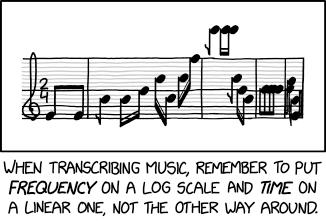Musical Scales

In the Hall of the Mountain King was accidentally composed on log/log paper.

In the Hall of the Mountain King was accidentally composed on log/log paper.
In standard Western musical notation, the horizontal position of a note indicates its relative temporal position in the piece, and the vertical position of a note denotes its pitch; but the pitch is really a logarithm of the note's frequency (every octave/seven named notes/12 semitones/13 named notes including accidentals equals a doubling of frequency), so it's a semi-log plot of sorts. The comic thus explores what a notation would look like if the horizontal axis behaved this way instead. Likewise, the vertical axis has been rendered linearly by frequency, with the normally equally-set lines on a normal musical staff stretching to compensate for the increasing jumps between pitches.
 The nonstandard music notation depicted in the comic is the opening five measures of "Simple Gifts" (listen.)
The nonstandard music notation depicted in the comic is the opening five measures of "Simple Gifts" (listen.)Randall may have mistakenly assumed that the lines of a music stave represent a linear increase in pitch and thus an exponential increase in frequency. He has thus mapped them onto a logarithmic scale by doubling the space between each successive line of the stave - one space between the bottom two lines, then two spaces, then four, then eight. In fact, the lines and the spaces between them correspond to notes in the C Major scale, which have unequal gaps between them. It is also possible that he is aware of this small inaccuracy and chose to ignore it in the name of humor.
The title text purports to explain how In the Hall of the Mountain King, which progressively increases in tempo/speed and intensity from an initially subtle start into a rapid hustle towards a series of crescendos at the end, was written on log-log paper, that features nonlinear expansion in both its axes (in order to render various exponential graphs linear, often for the purposes of ease of understanding). Rather than these features being a deliberate composition decision, this says that they're only the result of how it was written down, or thenceforth read. The accident would have to be that music was originally written as though for log-log paper, using shorter notes as the piece went on, intended to have consistent actual durations throughout the piece—and then interpreted on a linear time scale, such that the later notes actually had shorter durations, speeding up the piece.